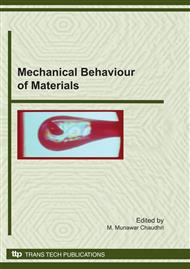p.1
p.13
p.27
p.39
p.53
p.77
p.85
p.95
Indentation of Ceramics, Some Highlights
Abstract:
Contact mechanics is widely used to explore the mechanical properties of brittle materials while it rules the mechanical performance of industrial pieces. Elastic, plastic and brittle responses can be investigated and are highlighted. The indentation plastic zone can be decomposed into a central highly strained zone and rosette arms. The evolution of the central zone extension can be predicted by Johnson’s cavity model obtained under full load while on the other hand rosette arm extension is to be modeled considering the residual stresses from the indentation. Upon a post heat treatment, further development is obtained both experimentally and theoretically. Using large loads, elimination of cracks can be achieved using higher temperature to pass the brittle-ductile transition.
Info:
Periodical:
Pages:
77-83
Citation:
Online since:
November 2010
Authors:
Keywords:
Price:
Сopyright:
© 2011 Trans Tech Publications Ltd. All Rights Reserved
Share:
Citation:


